The Impact of Wood Use on North American Forests
Planning Forests of the Future
Although approaches differ, effective multi-decade planning is a fundamental part of forest sustainability.
On national forests in the U.S., for example, conformance with the National Forest Management Act (NFMA) requires the development of a comprehensive plan, utilizing substantial public involvement and sound science to guide management decisions.
In Canada, where most forests are publicly owned, integrated land-use planning seeks to balance the economic, social and cultural opportunities in a forested area while maintaining the well-being of the forest. The public gets a say in decisions about how the land and its resources are managed; forest companies must solicit public input on their forest management plans, which must be approved by government agencies.
Through the use of diverse silviculture practices, foresters tend to the forest, ensuring regeneration, growth and forest health, and providing benefits that support a full range of forest values. For example, forest management practices are often selected to mimic natural disturbances and the cycles of nature that are associated with a specific region, forest type or species. Natural disturbances, including windstorms, hurricanes, ice storms, forest fires and insect or disease outbreaks, are a fact of life in the forest. To mimic these events, foresters may vary the size of the openings created by forest management, the intensity of management, the retention of wildlife reserve areas, and the frequency with which management occurs.

Photo courtesy of Weyerhaeuser
Managed forest in the Southern U.S.
Forest Regeneration
Following harvest, forests can be regenerated either naturally or through planting or seeding. One is not inherently better than the other. Rather, the choice of method varies based on factors that include biology of the tree species, availability of on-site seed sources, site ecology, type of harvest system employed and objectives for the site.
In Canada, where forest regeneration is required on public lands, just under half of the total harvest area is regenerated naturally and the rest through planting or seeding.12
Ensuring Healthy Forest Growth
After planting new trees, foresters use a variety of practices to support and encourage healthy forest growth, including understory thinning as well as understory planting and weeding. These treatments are applied to sustain ecosystem health and function, improve stand quality and produce desirable tree qualities that provide important economic and ecological values. They can also help to reduce the risk of wildfire in forests where previous fire prevention and other factors have resulted in an excess buildup of woody debris.
To control competing vegetation or brush, foresters use a variety of tools including chemical (e.g., herbicides), manual (e.g., saws and axes) and biological (e.g., sheep).
When properly used, herbicides can be an appropriate tool in a sustainably managed forest. In stands of pine and spruce, for example, pioneer plant species such as raspberry and trembling aspen thrive on disturbed sites with open growing conditions (i.e., following harvest), easily outcompeting newly planted seedlings for nutrients, light and water. Similar to a garden, weeds that are not controlled will take over and prevent the growth of desired species.
According to the U.S. Environmental Protection Agency (EPA), commercial and government use of herbicides (which includes forestry) accounts for 9 percent of use nationwide, while home and garden use accounts for 13 percent and the agricultural sector accounts for 78 percent.13
All pesticides applied in the U.S. must be registered with the EPA and must carry federally approved labels describing permitted uses and appropriate protection measures. To be registered, pesticides must be tested for effects on humans and the environment, and applicators of pesticides on forest land must also comply with state laws. In Canada, the Pest Management Regulatory Agency (PMRA) of Health Canada reviews and regulates all pesticide use under the federal Pest Control Products Act. Such registration indicates that, based on extensive expert review of all available scientific evidence, registered products have no potential for significant effects on human or environmental health when used as directed.

Photo: Colin Hackley, courtesy of Plum Creek
Thinning treatments were used in this Southern U.S. forest to support and encourage healthy growth.









